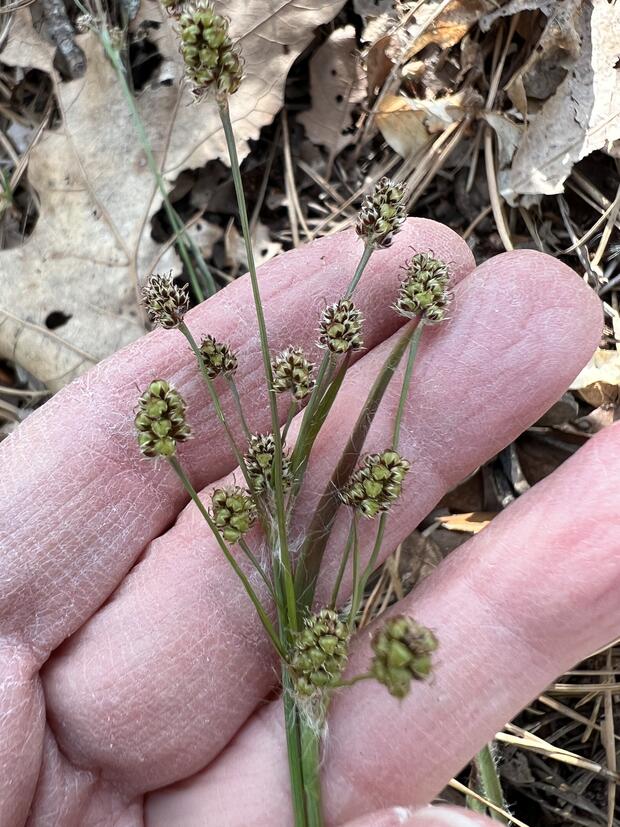- Scientific name: Luzula bulbosa (Wood) Smyth & Smyth
- Species of Greatest Conservation Need (MA State Wildlife Action Plan)
Description
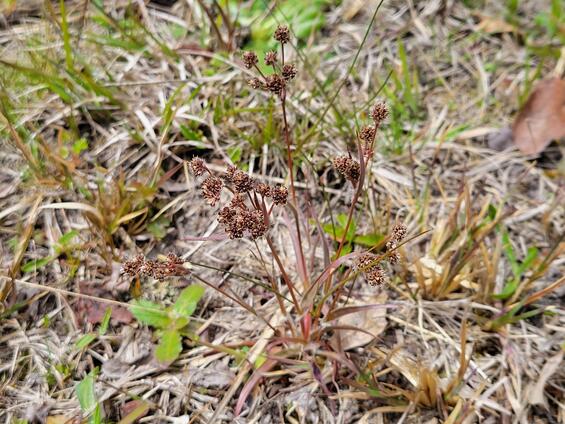
Photo by Kelly Oman.
Wood rushes are closely related to other true rushes in the genus Juncus but occupy generally only upland habitats and often in woods or partial shade. They bloom early in the spring but are often missed by naturalists as they look like short grasses and can easily hide within the other vegetation. Bulbous wood rush tends to be out where it is fully open and sunny, on sandy soils where there has been some disturbance such as a road or trail edge, or even a lawn edge that is mowed. Not much is known about this species as it was only recently separated taxonomically from other sister species, and it can be difficult to identify. A technical key and a ten-power hand lens are helpful. There is one feature, though, that is quite helpful. If the plant occurs on loose, sandy soil, it can be easily pulled up to examine the root crown. This species is one of the few to frequently have small but obvious whitish bulb-like structures at the base.
All rush flowers have six tepals which are in between sepals and petals in appearance, and tiny. This species has tepals only 3 mm (0.12 in) in length. The seed capsule usually extends just beyond the tip of the tepals when the dark brown to chestnut-colored capsule is ripe. The flowering stalk is typically about 20 cm (7.9 in) in height but can reach up to double that in some cases. The stems bear only 2–3 leaves, up to 17 cm (6.7 in) in length but generally shorter. The flowers are grouped tightly into glomerules of 6-20 flowers, with 3-20 glomerules per plant. Each glomerule is cylindric in shape, about 5-12 mm (0.2-0.47 in) in length and 5-7 mm (0.2-0.28 in) wide. These are held erect, not drooping. The seeds number three per capsule, are dark brown, 0.9-1.3 mm (0.04-0.05 in) long, and have a light-colored appendage called a caruncle that is 0.5-0.7 mm (0.02-0.03 in) long. This functions like similar appendages in violets and other woodland plant seeds that are attractive to ants, making it easy for them to carry the seeds back to their nests, assisting in seed dispersal and germination.
Life cycle and behavior
Bulbous wood rush is an herbaceous perennial.
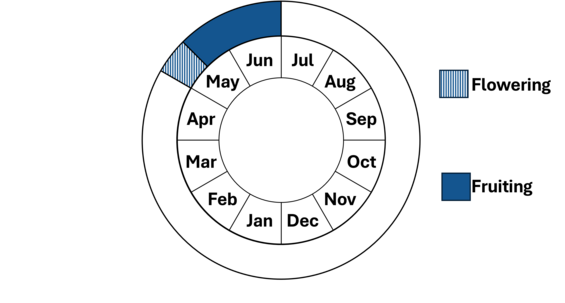
Population status
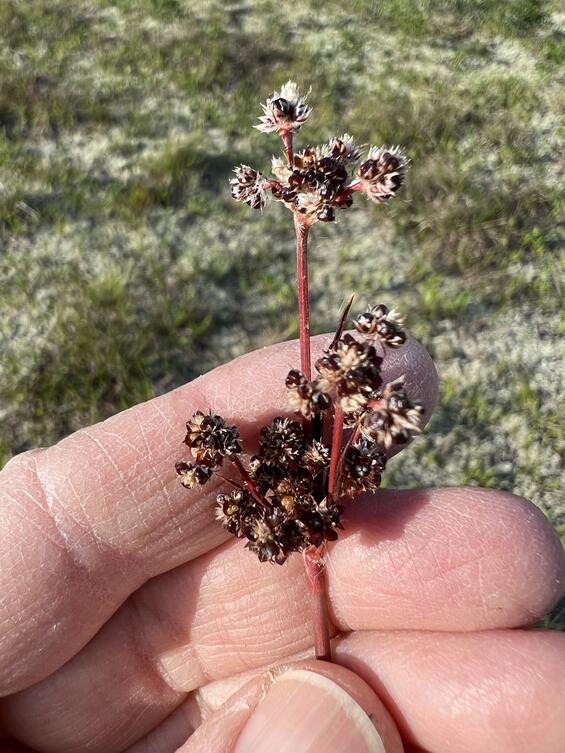
Phot by Margaret Curtin.
Our database contains 4 records since 1985 of bulbous wood rush with occurrences in Barnstable, Briston, and Plymouth Counties. iNaturalist shows 7 research-grade records from Dukes and Nantucket counties (iNaturalist 2025). Massachusetts herbarium records show 37 specimen records with a legible date. Of those, 18 (about half) were collected since 1987 (Consortium of Northeastern Herbaria 2025).
Distribution and abundance
Massachusetts is at the northeastern-most extent of the range of bulbous wood rush which extends then west and south to Kansas, and south to Texas and Florida with presences in all states (NatureServe 2025). It is considered apparently secure in Kentucky, secure in South Carolina and Virginia, and imperiled in Kansas, Ohio, Pennsylvania, New York, and Massachusetts (NatureServe 2025). It is not commonly observed though, with only 135 research grade observations across this entire range on iNaturalist (2025).
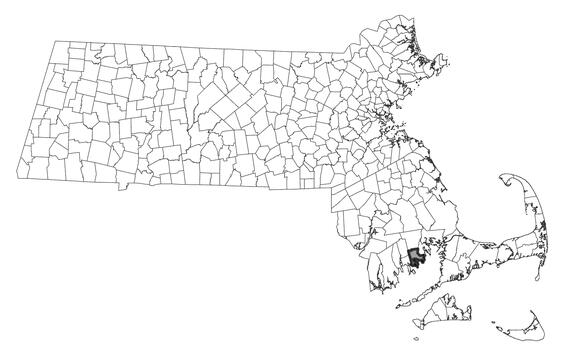
Distribution in Massachusetts. 2000-2025. Based on records in the Natural Heritage Database.
Habitat
In Massachusetts, bulbous wood rush plants occur on sandy glacial outwash plains and moraines on dry, open habitats such as fire lanes in pitch pine, scrub oak habitat, or sandplain grassland and heathland. Good habitat notes and associates have not been fully documented at this point. However, on at least one site occurs with warm season grasses and xeric specialists such as bear berry, little bluestem, post oak, scrub oak (two species), sweet fern, flax-leaved aster, sickle-leaved golden-aster, Bicknell's rockrose, Canada rockrose, Bushy rockrose (Crocanthemum dumosum), Low frostweed (Crocanthemum propinquum), lowbush blueberry, and black huckleberry (Dunwiddie pers comm 2024).
Healthy habitats are vital for supporting native wildlife and plants. Explore habitats and learn about conservation and restoration in Massachusetts.
Threats
The primary threats are development, habitat succession, lack of disturbance, and fire suppression.
Conservation
Much more survey work is needed to find more populations. One approach is to review old specimen data for locations and resurvey those sites to see if the plants might still be there. Surveys of known populations are needed to establish numbers and gather data on associated species, soil conditions, and former or current management practices on all populations.
Management should consist of mowing and controlled burns where possible to control shrub and invasive species.
Research is desperately needed to understand more about the habitat preferences and what kind of disturbance regimes will maintain or increase the populations without inviting other non-native weedy species to expand or take over a site.
Acknowledgement
MassWildlife acknowledges the expertise of Margaret Curtin, Gregory Palermo, and Kelly Omand whose field experience and high quality iNaturalist observations contributed substantially to the development of this fact sheet and the knowledge of this species in Massachusetts.
References
Coffey, J. C. 2025. Investigations in Luzula: Species of the Southeastern United States.
Consortium of Northeastern Herbaria. 2025. Herbarium records.
https://portal.neherbaria.org/portal/collections/list.php. Accessed 11 April 2025
Cullina M, Connolly B, Sorrie B, Somers P (2011) The vascular plants of Massachusetts: a county checklist, 1st revision. Massachusetts Natural Heritage & Endangered Species Massachusetts Division of Fisheries and Wildlife, Westborough, MA
Dunwiddie, Peter. 2024. Personal communication. Email to Robert Wernerehl.
Gleason, Henry A., and Arthur Cronquist. Manual of Vascular Plants of Northeastern United States and Adjacent Canada, Second Edition. Bronx, NY: The New York Botanical Garden, 1991.
Haines A (2011) New England Wild Flower Society’s Flora Novae Angliae: a manual for the identification of native and naturalized higher vascular plants of New England. Yale University Press. 1008 pp.
Hermann, F. J. 1938. New or otherwise interesting plants from Indiana. Rhodora 40: 77–86.
Holm, T. 1926. The bulbiferous form of Luzula multiflora. Rhodora 28: 133–138.
iNaturalist 2025. Available from https://www.inaturalist.org. Accessed 1 April 2025
Swab Janice Coffey. Luzula bulbosa - FNA. Flora of North America North of Mexico [Online]. Website http://dev.floranorthamerica.org/Luzula_bulbosa [accessed 11 April 2025]. Page version 30 July 2020. In: Flora of North America Editorial Committee, eds. 1993+. Flora of North America North of Mexico [Online]. 25+ vols. New York and Oxford. Vol. 23.
Native Plant Trust 2025. Luzula bulbosa (bulbous wood rush): Go Botany. Website https://gobotany.nativeplanttrust.org/species/luzula/bulbosa/ [accessed 11 April 2025].
Ohio DNR 2025. Southern Woodrush | Ohio Department of Natural Resources. Website https://ohiodnr.gov/discover-and-learn/plants-trees/flowering-plants/bigleaf-magnolia [accessed 11 April 2025].
NatureServe. 2025. NatureServe Network Biodiversity Location Data accessed through NatureServe Explorer [web application]. NatureServe, Arlington, Virginia. Available https://explorer.natureserve.org/. Accessed: 4/3/2025
Contact
| Date published: | April 30, 2025 |
|---|
